STAR’s Reading FC Hall of Fame
Honouring outstanding individuals who have made a significant contribution to the history of our club.
The Hall of Fame is a work-in-progress project scheduled to complete on the 150th anniversary of Reading FC’s first match in 1872. Each year between 2016 and 2022 11-25 new names will be added (inducted) into the Hall of Fame.
Please see Hall of Fame nomination process.

100 years as a league club
Our first one hundred years as a League club
On 28 August 1920 Reading’s first game in the Football League ended in a 1-0 win at Newport County. How have we got on in the 4,155 matches over the hundred years since? And how does that compare with the 21 other southern clubs who kicked off League life in the new Division Three on the same day?
Looking back from 2020 many supporters might think that this was the moment our ‘real’ history as a club began and that getting into the League in 1920 was a cause of great celebration. They would be wrong on both counts.
Read More......
Southern League glory days
From 1894-95 to 1919-20 the Biscuitmen were members of the Southern League which was a strong, and now under-estimated, competition. During that period we reached the FA Cup quarter-finals, beat several Division One sides in the Cup, staged an FA Cup semi-final at Elm Park, saw two of our players picked for England and others in the Great Britain Olympic gold medal team, toured Italy successfully, wiping the floor with AC Milan, and, in terms of the bread and butter, finishing runners-up three times and, in our only season in SL Division Two, taking the title. If you divided Reading’s 150 year history into six equal 25 year slices this would be our second most successful. Recent statistical work by University of Reading suggests that, on the playing side, we were at times at the level of Football League Division One before the first World War.
Yet during this period there was never any question of Reading applying for Football League membership and joining its Division Two. Indeed as late as 1919 the Reading directors were reportedly against it. There was a strong northern bias against teams from smaller southern towns, like Reading. We knew our place! The Southern League as a whole tried several times to negotiate accession to the Football League, usually as a kind of Division Two (South) but were continually knocked back and relations between the two bodies worsened. Finally, after the 1914-18 war, the Football League agreed to admit the Southern League Division One clubs en masse in a new Division Three but the terms were harsh. They were to be associate members only (that’s where the term ‘lower divisions’ comes from) with paltry voting rights and worse still there was to be only one promotion place available, a daft and hostile arrangement that persisted until 1958.
What was it like back in the 1920s?
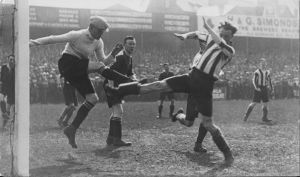
So as Reading lined up for the start of the 1920-21 season there was not much joy or celebration to be found in the local press. Admission prices were unchanged – the most expensive season ticket was £4.20. Reading would be playing exactly the same teams as before the war in a tough division we’d never won and for a one in 22 chance of promotion. It might have looked like we were worse off than before! However five years later in 1925-26 we won Division Three (South) and took our place as full members of the Football League for the first time in 1926 – the same year that the Norfolk Road (north stand) was built at Elm Park. For five more seasons we had a good and glamorous time in Division Two (and reached the FA Cup semi-final in 1927) before a tragic relegation in 1931.
A long stalemate
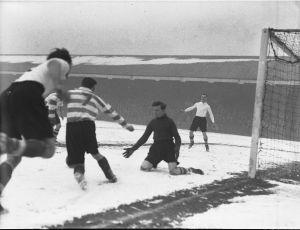
It was back to the lower divisions for the next 55 years. We finished second four times and third three times but could never quite get that one promotion place on offer from Division Three (South). Ironically, don’t laugh, in 1995 there was also only one automatic promotion place on offer from the second tier. We finished second that year too and lost in the play-off final. We had twenty seasons in a row in Division Three (South) followed by thirteen in Division Three (1958-71) before going down to Division Four for the first time, just as our club centenary happened in 1971. It was this long period in the wilderness that did so much to shape the image of Reading as a ‘typical Third Division’ club.
A remarkable catalyst
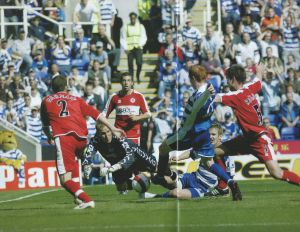
The drift in the lower divisions continued with a third relegation to Division Four in 1983. But the thwarted ‘merger’ with Oxford United in that year acted as a catalyst for success. Two promotions in three years brought us back to Division Two (a short-lived stint, 1986-88), an era that also brought triumph at Wembley in the Simod (full members) Cup in 1988. A financial crisis in 1990 led to Sir John Madejski assuming the ownership of the club, the move to the Madejski Stadium in 1998 and the most successful 25 year slice in the club’s long history. Promotions in 2002 and 2006 brought Reading to the top division for the first time, the second tier title (now called the Football League championship) was won again in 2012 and the FA Cup semi-final reached in 2015. Reading have now been above ‘the lower divisions’ for a club record 18 consecutive seasons.
Where did we finish in the class of 1920?
Of the 22 clubs joining the League 100 years ago Reading presently stand tenth highest in the league tables. Two of our oldest rivals, of similar stature, are Swindon and Millwall. We played them in friendlies before the Southern League was founded in 1894 and throughout the Southern League days, with all three clubs starting League football on the same day in 1920. Here’s the comparative record of how many seasons we have spent in each division.
| Division / Tier | Reading | Swindon | Millwall |
| First | 3 | 1 | 2 |
| Second | 26 | 18 | 42 |
| Third | 30 | 34 | 22 |
| Third South | 26 | 31 | 22 |
| Fourth | 8 | 9 | 5 |
| War time | 7 | 7 | 7 |
Each club has had short spells in the top division (all since 1988) and the bottom division. Of the 22 new entrants to Division Three in 1920 Southampton and Portsmouth have been the most successful. Fifteen of the class of 1920 have reached the top flight and only one (Merthyr) is now outside the League. By contrast none of the nineteen clubs coming in as Third Division (North) in 1921 has achieved this and only six are still in the League. Division Three between 1921 and 1958 was a division of two unequal north and south halves.
Unlike, say, Bristol Rovers or Newport County, Reading’s membership of the League (or Premier League) has been continuous. Though it was close once or twice the club has never finished so low that it has had to apply for re-election to the League (a process replaced by automatic relegation in 1987). Well, almost continuous: Reading were once expelled from the Football League! It happened in 1941 as a consequence of a dispute between the League and London and southern clubs about war-time fixtures. Fifteen were chucked out but re-instated a few months later, all forgotten about now. Mathematically our lowest finish was 16th in Division Four in 1971-72 though we came closer to needing to seek re-election a couple of times in Division Three (South) in the early 1920s and mid-1950s.
Our glittering prizes
On the brighter side we have won every Football League division we’ve competed in – the Premier League is sadly another matter, our best finish there being 8th in 2006-07. In total we have two second tier titles, three third tier titles, one fourth tier title and one Division Three (South) title. To this trophy haul can be added two more promotions from Division Four and another from the third tier, a total of ten promotions in 93 playing seasons.
Amongst our other notable achievements at a League level is of course the record of 106 points in a season (2005-06) – though on a points per game basis a few other clubs could happily dispute this! Nevertheless we managed 34 games unbeaten, still a second tier record. Indisputably we have the longest 100% record from the start of the season – 13 matches in 1985-86. For thirty years we held the longest unbeaten home record of 55 matches, set in the mid-1930s, and we were the first of the new Division Three clubs to score 5000 League goals (a scrambled effort by Ady Williams in 2002).
It has taken the best part of a century of League membership to re-gain the position which we held in the football world of the early 20th century. For the first sixty years or so the Football League gave us status if not as much joy as we might have had under a fairer promotion system. But we end this century of league membership, like many of our southern class-mates of 1920, as clubs well-established in the top half of the national structure.
The complete record
Our complete playing record – excludes play-offs and curtailed 1939-40 season:
P4156 HW 1146 HD 479 HL 453 HF 3740 HA 2144
AW 516 AD 559 AL 1003 AF 2404 AA 3555
Total W1662 D1038 L1456 F6144 A5699 GD +445
We passed 5000 league points early in the 2019-20 season and our total now stands at 5052. Before 1981-82 two points were awarded for a win; since then, it’s been three.
Roger Titford


Historical Team Images - The Parsons Collection
One night in 1999 a ‘mature’ gentleman by the name of Parsons came to The Football Shop (the old RFSC HQ in the East Stand) and said ‘you might be interested in these.’ It was three albums of football postcards dating from the late 1890s through to the late 1920s, a mix of team groups and players and I‘d never seen anything quite like it before.
He said it had been his father’s and, as he’d no further use for them, he was giving it to me in the hope we could use it for the benefit of the supporters of Reading FC. There were about 80 cards altogether which I took along to the next meeting of the RFC Collectors and Historians Society. They considered that it was the best collection of such material to come to light for many years and it included some items no-one had seen before.
We decided to keep the Reading part of the collection as an asset of the Supporters’ Club (and later STAR). About a third of the material related to other clubs (Southampton, Villa, West Brom principally) and this we sold for a few hundred pounds. STAR can offer for sale copies of the Reading photos you can see on this site.
One of the many roles of STAR is to enrich and protect the heritage of Reading FC, particularly in the absence of any formal museum run by the football club. Of course we welcome more donations of significant material from Reading fans with the promise we’ll look after it and make it as widely accessible as possible.
You can view the photos from the Parsons Collection by clicking the button below.
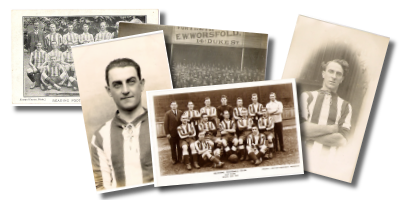
STAR, RFC and Reading Museum Loan Box Project
We currently work with the Reading Museums Service having produced a ‘hands-on loan box’ of Royals’ artefacts which is available to schools and old people’s homes across the county. It includes such articles as a rattle (seen right), old programmes, a scarf, rosette and early supporters’ badge among other items.
Details of the Reading football loan box can be downloaded here. We have renewed the agreement with Reading Museum to continue to make the loan box available to 2015 which is one of 1500 boxes in their loan service.
The boxes are borrowed by schools for half a term, this gives the pupils a chance to properly explore the objects and use them in different classes, not just history! Further information about the service is available on the Reading Museum website.
Roger Titford, Chairman RFSC (1998-2001)
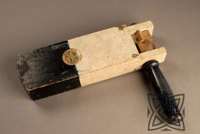
Will of Footballers Battalion & Former RFC Player Ben Butler Uncovered
In June 2011 military historian Jon Cooksey and BBC radio presenter, Graham McKechnie guided a group of STAR members in a visit to the last resting places of a number of former RFC players who joined ‘the footballers’ battalion’ and lost their lives during the First World War. One such former player was Cpl Albert Victor (Ben) Butler.
The last wishes, thoughts and concerns of more than 230,000 soldiers who died on the front line during World War I are to be made available online as part of a larger project to make all war wills publicly available, dating from the Boer War to the Falklands. Final handwritten wills were kept by troops in their pocket service books and tucked into their uniforms and give a fascinating insight into the thoughts of those brave men.
You can find out more about the project and some of those wills, including that of Ben Butler, by reading Jon’s articles written for the launch of the project:
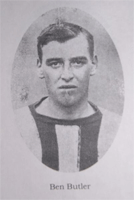
Commemoration of War-Time Deaths of Former Reading Players
STAR hold ceremonies at the Memorial Wall at the Madejski Stadium to commemorate the 100th anniversary of a former players war-time death. The below photographs were at the first ceremony for Jack Huggins and Joe Dickenson. STAR Chairman Paul Ellix paid tribute to both men in a short speech. Joe Dickenson’s grand-daughter Cherry Clifford and great grand-daughter Kirsten Gregory attended and, together with Melanie Bishop of STAR, laid wreaths.
You can read more about Joe Dickenson – the Footballing Grenadier by downloading a commemorative profile produced by STAR Chairman Paul Ellix.
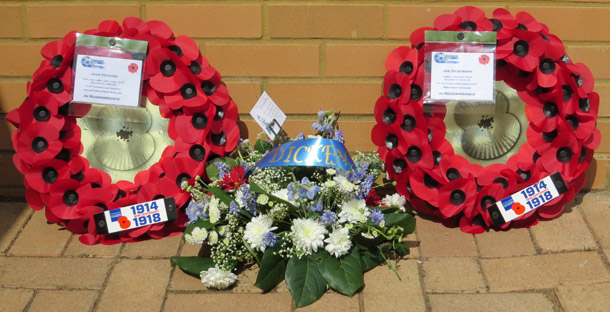
Football Battalion Memorial Wall
Following the trip to the Somme at the end of the 2011-12 season STAR felt we needed a more permanent memorial to Reading players who gave their lives for their country. As a result, there is now a brick and marble panel in the wall at the corner of the South Stand of the Madejski Stadium. These bricks display the names of the 9 Reading players killed in World War I and the 3 Reading players killed in World War II. Take a look next time you visit the ground.
Pictured are Carol Buckell, Darel Melhuish and Gail Lowes with the bricks that bear the names of their relations before being placed in the wall.
STAR are grateful to those who donated their time and donations to support the Memorial Wall.
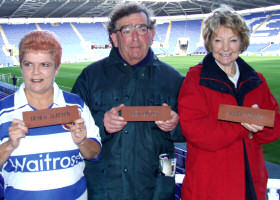
STAR Flanders Trip 2014 - A Journey of Remembrance
On 30th and 31st May, this year STAR organised a visit to the battlefields of Flanders for members to view the final resting places of Reading players who had fought in the First World War in what became known as the ‘Footballers Batallion’. This followed a similarly successful visit to the Somme in June 2011.
A special edition of Reading Matter – 2014 Flanders Tour of Remembrance – is available covering the visit, a copy of which can be downloaded here (pdf).
Thank you to Pete Vickery for putting the document together and to Mel Bishop for additional photography.
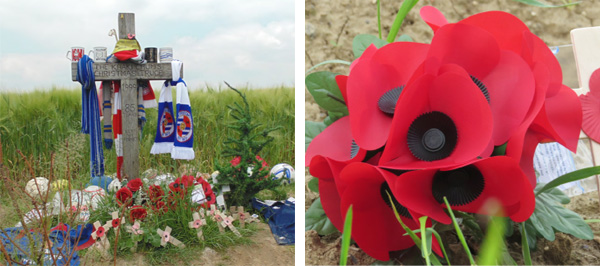
The Real Early History of Reading FC
Almost every history of Reading FC has depended on the first account of its early years written, anonymously, in 1906.
It contains numerous errors and biases uncovered by Roger Titford in his 2016 publication of ‘The Lost Years of Reading FC’.
To set the records straight we’re pleased to present an excerpt from his book.

Historical RFC Kits
You can view all the Reading FC kits from 1872 to the present design on the Historical Kits website.
RFC Former Players Association
The Association represent former managers and players, currently standing at 200 members, spanning decades from the 1940s to today. You can visit their website to keep up to date with their news and events.
1983 - One man and a mad dream
The strange story of Robert Maxwell and the Thames Valley Royals. In 1983 Reading FC nearly ceased to exist. A plan to merge Oxford United and Reading to form a new team called Thames Valley Royals nearly succeeded. Read an account of this troublesome time for Reading Supporters that first appeared on 1st April 1993 in Rage Online – an independent voice of Oxford United Supporters.
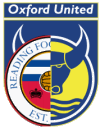
More RFC Historical Sites
You can see a further collection of RFC Cards put together by Chris Lee, with information about the RFC Society of Collectors and Historians by visiting his website. You can find out more from Chris following @cribsie on Twitter.
I am text block. Click edit button to change this text. Lorem ipsum dolor sit amet, consectetur adipiscing elit. Ut elit tellus, luctus nec ullamcorper mattis, pulvinar dapibus leo.

